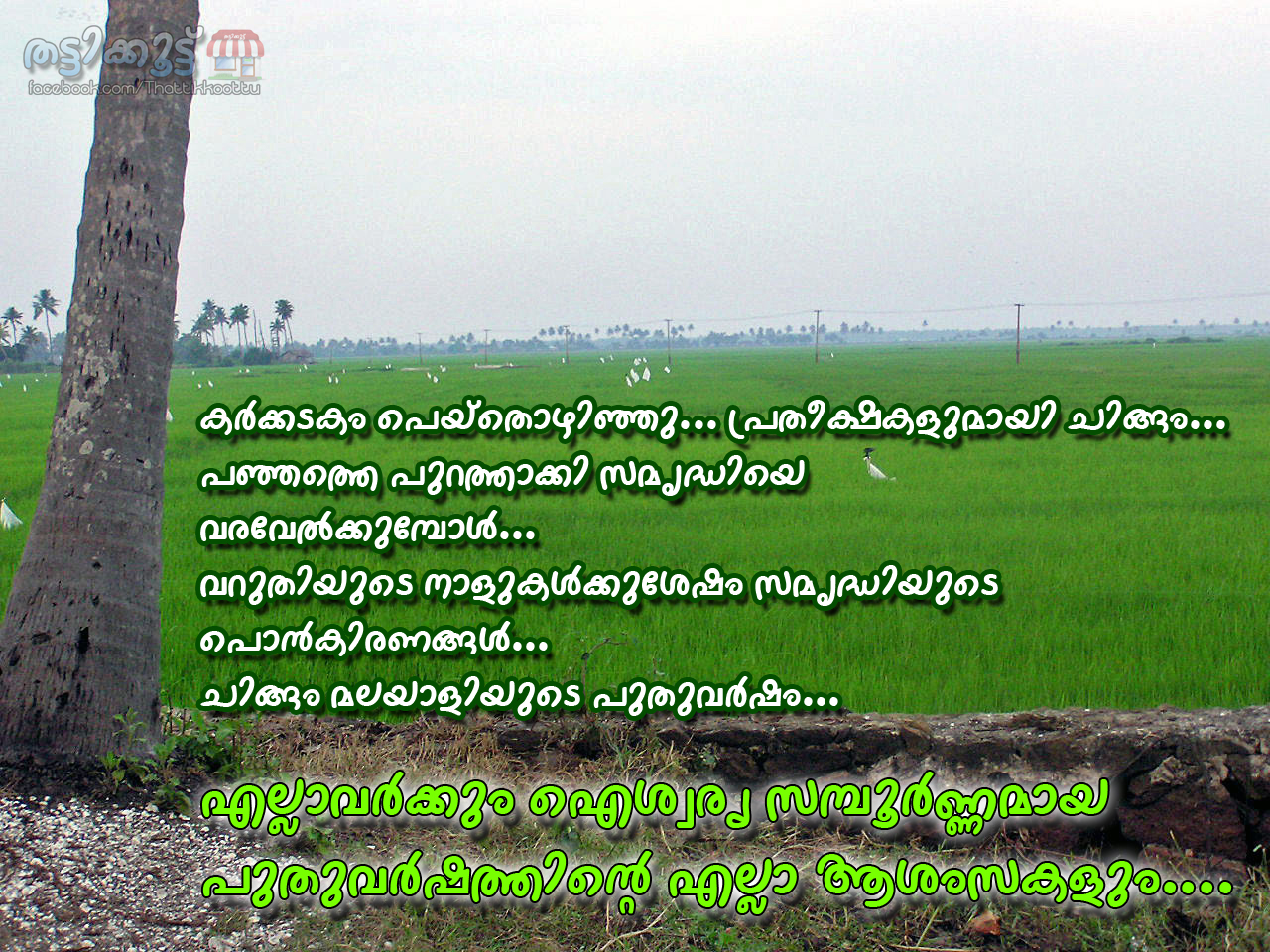Chingam 1 (Chingam Onnu) is the Keralites New Year Day as per the Kerala calender Kollavarsham. 'Chingam' is my favorite month in the Malayalam calender and so is 'August' in the English calender. Keralites celebrate Onam with the biggest pomp and show. Floral Rangolis ( Pookkalam) are made in courtyards on each of these 10 days.
പുതുവത്സരം സമാഗതമായി. ഒരുപാട് പ്രതീക്ഷകളായി പുതു വര്ഷത്തെ
വരവേല്ക്കാന് മലയാളികള് ഒരുങ്ങുകയായി. നഷ്ടപ്പെടലുകളുടെയും
കൂടിച്ചേരലുകളുടെയും പോയ വര്ഷം. നാം ഓരോരുത്തര്ക്കും നന്മകളും സന്തോഷവും
നല്കിയ വര്ഷം. പലര്ക്കും കുടുംബത്തില് പുതു അംഗങ്ങള് പിറന്ന വര്ഷം
അതുപോലെ നമ്മുടെ ഉറ്റവര് വിട്ടുപിരിഞ്ഞ നിമിഷം.
ലോകത്തുള്ള എല്ലാ മലയാളികള്ക്കും ഐശ്വര്യത്തിന്റെയും സമൃദ്ധിയുടെയും ഒരു പുതുവര്ഷം ആശംസിക്കുന്നു
ലോക ജനതയുടെ നന്മക്കായി പ്രാര്ത്ഥിക്കുന്നു .
വറുതികള്ക്ക് വിട ചൊല്ലി ചിങ്ങ പൊന് പുലരി ആഗതമായ്. ഐശ്വര്യവും
സമ്പല് സമൃദ്ധിയും നിറഞ്ഞ ഒരു പുതുവര്ഷത്തെ വരവേല്ക്കാന് മലയാളികള്
ഒരുങ്ങി കഴിഞ്ഞു.
എല്ലാ മലയാളികള്ക്കും ഹൃദയം നിറഞ്ഞ പുതുവല്സരാശംസകള്
!!

Malayalam Calendar or the Kolla Varsham is the
traditional calendar followed in Kerala. Earlier Malayalam calendar
dates were followed to determine birthdays and important festivals in
Kerala. Even today, many major festivals and important events,
ceremonies in temples in Kerala depend on Malayalam calendar and
nakshatras (stars).
Malayalam Calendar, Malayalam Era or Kollavarsham or Kollam Era is a
solar and sidereal Hindu calendar used in Kerala, India. The origin of
the calendar has been dated as 825 CE.
Hindus of Kerala are using Malayalam Calender for there religious,
cultural and cultivation activities. The Malayalam New Year 1189 Chingam 1st
is on August 17, Saturday and is the beginning of Chinga Masam.
As per
Malayalam Calender the Kolla Varsham 1189 begins on August 17 2013. The first
day of Chingam month is welcomed by people of Kerala with special
poojas and prayers. Hindus in large numbers visit their near by
temples and in some part of the Kerala parents were give Kai Neettam to
their children.
There are many theories about the origin of the calendar. One is that it
was started with the reopening of the natural disaster destroyed city
of Kollam on the Malabar coast by Mar Abo, an Assyrian saint who ruled a number of churches in Travancore with Syrian liturgy.
Some argue that it was founded by the ruler of Venad Udaya Marttanda
Varma (a feudatory with capital at Kollam) or by the Vedic philosopher
Adi Shankara
on the backdrop of the shivite revival among the vaishnavite Nambuthiri
Community who are considered to be the ' Nampthali' lost Tribe of the
Jews or simply it is a derivation of the
Saptarshi Era.
കൊല്ലവർഷത്തിലെ പ്രഥമ മാസമാണ്
ചിങ്ങം.സൂര്യൻ ചിങ്ങം രാശിയിലൂടെ
സഞ്ചരിക്കുന്ന സമയമാണ് ചിങ്ങമാസം. മലയാളികളുടെ പ്രിയങ്കരമായ ഉത്സവമായ ഓണം
ചിങ്ങമാസക്കാലത്താണ്. മാസങ്ങൾക്ക് പേരു കൊടുത്തിരിക്കുന്നത്
നക്ഷത്രരാശികൾക്ക് അനുസരിച്ചാണ്.
സിംഹം എന്ന പദം ലോപിച്ചുണ്ടായ ചിങ്ങം
സിംഹത്തിന്റെ രൂപത്തിലുള്ള ലിയോ എന്ന നക്ഷത്രഘടനയെ സൂചിപ്പിക്കുന്നു. തമിഴ്
മാസങ്ങളായ ആവണി-പൂരട്ടാശി എന്നിവ ചിങ്ങമാസ സമയത്താണ്. ഓഗസ്റ്റ് -
സെപ്റ്റംബർ മാസങ്ങളിലായി ആണ് മലയാളമാസമായ ചിങ്ങം വരിക.
പൊന്നോണ മാസം എന്നതിന് ഉപരി ഇപ്പോള് ചിങ്ങം മലയാള ഭാഷാ മാസവും കൂടിയാണ്.
ചിങ്ങം ഒന്ന് കര്ഷക ദിനം കൂടിയാണ്. മലയാളിയ്ക്ക്
അന്യമായിക്കൊണ്ടിരിയ്ക്കുന്ന കൊയ്താണ് ചിങ്ങമാസത്തിലെ പ്രധാന വിശേഷം.
പാടത്ത് വിളഞ്ഞ പൊന്കതിര് വീട്ടിലെത്തിച്ച് അറകളും പത്തായങ്ങളും
നിറയ്ക്കുന്ന സമ്പന്നതയുടെ മാസം.
വര്ഷം മുഴുവന് സുഖവും സമ്പര് സമൃദ്ധിയും കിട്ടാന് വിശ്വാസികളൊക്കെ
ആരാധനാലയങ്ങള് സന്ദര്ശിയ്ക്കുന്ന ദിവസമാണ് ചിങ്ങം ഒന്ന്. പ്രത്യേകിച്ചും
ഹിന്ദുക്കള്. എല്ലാ ഹിന്ദു ദേവാലയങ്ങളിലും പ്രത്യേക പൂജകളും ഉത്സവവും ഈ
ദിവസം ഉണ്ടാവും.
ഒരു വർഷത്തിന്റെ അവസാനവും മറ്റൊരു വർഷത്തിന്റെ തുടക്കവുമായി വരുന്ന
ദിവസങ്ങളിൽ ചില സംസ്കാരവുമായി ബന്ധപ്പെട്ടുകിടക്കുന്ന ആഘോഷമാണ്
പുതുവത്സരം. പല രാജ്യങ്ങളിലുമായുള്ള വ്യത്യസ്ത കലണ്ടർ സമയങ്ങളിലാണ്
പുതുവത്സരം ആഘോഷിക്കുന്നത്. ഒരു പുതുവഝരത്തിൽ നിന്ന് അടുത്ത
പുതുവഝരത്തിലേക്ക് മുന്നൂറ്റിയമ്പത്തിയാറേ കാൽ ദിവസം വരും
According to Sun's transit Keralites are celebrating new year day as the first day of the month of
Mesha or Medam. This day signifies the Sun's transit to the zodiac Mesha
Raasi. Currently, it occurs around April 15 on the Gregorian calendar
and is celebrated as Vishu.
But now Chingam 1 (around August 15) is
celebrated as the new year day. The month Chingam starts in the mid
August corressponds to harvest and Onam festival is celebrated in this
month. The last month of Malayam Calendar Karkkidakam
corresponds the month when the South west monsoon is active. This month
is also considered to be bad time as in olden days rains used to bring
diseases and damages to lives and property.
Karkkidakam is generally
known as the Panja Masam, the month of famine, because of the lack of
work during the peak of monsoon. Scripture from Ramayana will be recited
till the end of the month and people will abstain from entering into
any new ventures or holding auspicious functions during this month.
Hence it is also called Ramayanamasam.
The agricultural activities of
Kerala are centred around the seasons. The Southwest monsoon which
starts around June 1 is known as Edavappathi, meaning mid- Edavam. The
North east monsoon which starts during mid October is called
thulavarsham (rain in the month of thulam).
The two harvests of paddy
are called Kannikkoythu and Makarakkoythu (harvest in the month kanni
and makaram) respectively. The Makaravilakku festival is celebrated in
the Ayyappa Temple at Sabarimala on the 1st day of month Makaram.
കേരളത്തിന്റേതു
മാത്രമായ കാലഗണനാരീതിയാണ് കൊല്ലവർഷം, അതുകൊണ്ടുതന്നെ കൊല്ലവർഷം മലയാള
വർഷം എന്നും അറിയപ്പെടുന്നു. എ.ഡി. 825-ൽ ആണ് കൊല്ലവർഷത്തിന്റെ തുടക്കം.
ഭാരതത്തിലെ മറ്റു പഞ്ചാംഗങ്ങൾ സൗരവർഷത്തെയും ചാന്ദ്രമാസത്തെയും
അടിസ്ഥാനമാക്കി കാലനിർണ്ണയം ചെയ്തപ്പോൾ, കൊല്ലവർഷപ്പഞ്ചാംഗം സൗരവർഷത്തെയും
സൗരമാസത്തെയും ഉപയോഗിച്ചു. വേണാട്ടിലെ രാജാവായിരുന്ന ഉദയ മാർത്താണ്ഡ
വർമ്മയാണ് കൊല്ലവർഷം തുടങ്ങിയതെന്ന് വിശ്വസിക്കപ്പെടുന്നു. ചിങ്ങം, കന്നി
തുടങ്ങി 12 മലയാള മാസങ്ങളാണ് ഉള്ളത്.
മലയാള മാസം (Month)
The Malayalam months are named after the Signs of the Zodiac. Thus Cingam (from
Simham or Lion) is named after the constellation Leo and so on. The following are the months of the astronomical Malayalam calendar:

Comparative table showing corresponding months of other calendars
| Months in Malayalam Era |
In Malayalam |
Gregorian Calendar |
Tamil calendar |
Saka era |
Sign of Zodiac |
| Chingam |
ചിങ്ങം |
August–September |
Aavani |
Sravan–Bhadrapada |
Leo |
| Kanni |
കന്നി |
September–October |
Purattasi |
Bhadrapada–Asvina |
Virgo |
| Tulam |
തുലാം |
October–November |
Aippasi |
Asvina–Kartika |
Libra |
| Vrscikam |
വൃശ്ചികം |
November–December |
Karthigai |
Kartika–Agrahayana |
Scorpio |
| Dhanu |
ധനു |
December–January |
Margazhi |
Agrahayana–Pausa |
Sagittarius |
| Makaram |
മകരം |
January–February |
Thai |
Pausa–Magha |
Capricon |
| Kumbham |
കുംഭം |
February–March |
Maasi |
Magha–Phalguna |
Aquarius |
| Minam |
മീനം |
March–April |
Panguni |
Phalguna–Chaitra |
Pisces |
| Medam |
മേടം |
April–May |
Chithirai |
Chaitra– Vaisakha |
Aries |
| Edavam (Idavam) |
ഇടവം |
May–June |
Vaikasi |
Vaisakha–Jyaistha |
Taurus |
| Mithunam |
മിഥുനം |
June–July |
Aani |
Jyaistha–Asada |
Gemini |
| Karkadakam |
കര്ക്കടകം |
July–August |
Aadi |
Asada–Sravana |
Cancer |

Malayalam Calender came to be called 'Kolla Varsham' after the town of Kollam(Quilon) which was the capital the Kingdom
of Venad. The city, also a major coastal town, a significant
industrial and commercial trading center. Kollam has been described
in history as one of the finest Cities in Malabar.
കൊല്ലവർഷത്തിലെ പ്രഥമ മാസമാണ് ചിങ്ങം.സൂര്യൻ ചിങ്ങം രാശിയിലൂടെ
സഞ്ചരിക്കുന്ന സമയമാണ് ചിങ്ങമാസം. മലയാളികളുടെ പ്രിയങ്കരമായ ഉത്സവമായ ഓണം
ചിങ്ങമാസക്കാലത്താണ്. മാസങ്ങൾക്ക് പേരു കൊടുത്തിരിക്കുന്നത്
നക്ഷത്രരാശികൾക്ക് അനുസരിച്ചാണ്. സിംഹം എന്ന പദം ലോപിച്ചുണ്ടായ ചിങ്ങം
സിംഹത്തിന്റെ രൂപത്തിലുള്ള ലിയോ എന്ന നക്ഷത്രഘടനയെ സൂചിപ്പിക്കുന്നു.
Azhca ആഴ്ച - Week
The days of the week in the Malayalam calendar are suffixed with
Azhca (
ആഴ്ച - week).
Comparative table showing corresponding weekdays
| Malayalam |
മലയാളം |
English |
Kannada |
Tamil |
Hindi |
|
| Njayar |
ഞായര് |
Sunday |
Bhanuvara |
Nyaayiru |
Ravivar |
| Thinkal |
തിങ്കള് |
Monday |
Somavara |
Thinkal |
Somvar |
| Chowva |
ചൊവ്വ |
Tuesday |
Mangalavara |
Chevvai |
Mangalvar |
| Budhan |
ബുധന് |
Wednesday |
Budhavara |
Budhan |
Budhvar |
| Vyazham |
വ്യാഴം |
Thursday |
Guruvara |
Vyazhan |
Guruvar |
| Velli |
വെള്ളി |
Friday |
Shukravara |
Velli |
Sukravar |
| Shani |
ശനി |
Saturday |
Shanivara |
Sani |
Shanivar |
Like the months above, there are twenty seven stars starting from Aswati
(Ashvinī in Sanskrit) and ending in Revatī. The 365 days of the year
are divided into groups of fourteen days called
Nhattuvela, each one bearing the name of a star.
നക്ഷത്രം Nakshathra - 27 Stars
According to Indian Astrology there are 27 Nakshatras
or stars in the zodiac belt. The ecliptic is divided into 27
nakshatras, which are variously called lunar houses or asterisms. The
zodiac comprises of 360 degrees. Therefore, the value of each
constellation is 13 degrees and 20 minutes when measured from the fixed
initial point. These 27 Nakshatras(stars) complete the entire circle of
360 degrees of the zodiac. These reflect the moon's cycle against the
fixed stars, 27 days ,7 hours and 45 minutes. Nakshatra computation
appears to have been well known at the time of the Rig Veda.

The
starting point for this division is the point on the ecliptic directly
opposite to the star Spica called Chithra in Sanskrit. (Other
slightly-different definitions exist.) It is called Meshaadi or the
"start of Aries". The ecliptic is divided into the nakshatras eastwards
starting from this point. Note that nakshatra-s are (in this context)
not just single stars but are segments on the ecliptic characterised by
one or more stars. Hence you will find many stars mentioned for one
nakshatra. An additional 28th intercalary nakshatra, Abhijit (alpha,
epsilon and zeta Lyrae - Vega - between Uttarasharha and Sravana), is in
between Uttarashada and Sravana. Last two (third and fourth) Padas of
Uttrashada and first two (first and second) Padas of Sravana are
considered to be Abhijith. The nakshatra in which the moon lies at the
time of sunrise of a day is the nakshatra for the day.
Comparative table showing corresponding names of 27 Nakshatras in the zodiac belt
| Malayalam |
Sanskrit |
Tamil |
Name of Constellation |
Meaning of the name |
| Ashwathi |
Ashwini |
Ashwathi |
Beta Arietis |
Horseman |
| Bharani |
Bharani | Bharani |
41 Arietis |
The Bearer |
| Karthika |
Krittika | Karthigai |
Eta Tauri |
Perspiring |
| Rohini |
Rohini | Rohini |
Alpha Tauri |
The Red One |
| Makayiram |
Mrigashira | Mrigasheersham |
Lamda Orionis |
Deer's Head |
| Thiruvathira |
Ardra | Thiruvaathirai |
Alpha Orionis |
Moist |
| Punartham |
Punarvasu | Punarpoosam |
Beta Geminorum |
Good Again |
| Pooyam |
Pushya | Poosam |
Delta Cancri |
Nourishing |
| Aayilyam |
Ashlesha | Aayilyam |
Alpha Cancri |
The entwiner |
| Makam |
Magha | Makam |
Alpha Leonis |
The Mighty One |
| Pooram |
Poorvaphalguni | Pooram |
Delta Leonis |
The Fig Tree |
| Uthram |
Uttaraphalguni | Uthiram |
Beta Leonis |
The latter red one |
| Atham |
Hastha | Hastham |
Delta Corvi |
Hand |
| Chithira |
Chithra | Chithirai |
Alpha Virginis |
Brilliant |
| Chothi |
Swathi | Swathi |
Alpha Bootis |
The lead goat in a herd |
| Vishakham |
Vishakha | Visaakham |
Beta Librae |
Forked Branch |
| Anizham |
Anuradha | Anusham |
Delta Scorpi |
Success |
| Thrikketta |
Jyeshtha | Kettai |
Alpha Scorpi |
Eldest |
| Moolam |
Moola | Moolam |
Lamda Scorpi |
The Root |
| Pooradam |
Poorva ashadha | Pooraadam |
Delta Sagittari |
The Former Unsubdued |
| Uthradam |
Uttarashadha | Uthiraadam |
Delta Sagittari |
The Latter Unsubdued |
| Thiruvonam |
Shravana | Thiruvonam |
Alpha Aquilae |
Ear of Hearing |
| Avittam |
Dhanistha | Avittam |
Alpha Delphini |
Wealth |
| Chathayam |
Shatabhishaj | Chathayam |
Lamda Aquari |
100 Physicians |
| Poororuttathy |
Poorva bhadrapada | Poorattathi |
Alpha Pegasi |
Former Beautiful Foot |
| Uthruttathy |
Uttara bhadrapada | Uthirattathi |
Alpha Andromeda |
Latter Beautiful Foot |
| Revathy |
Revathy | Revathy |
Zeta Piscium |
Wealthy |
തിഥി - Tithi
The (anticlockwise) angular distance between the sun
and moon as measured from the earth along the ecliptic (circle on the
sky in which the sun, moon and planets seem to move) can vary between 0
and 360 degrees. This is divided into 30 parts. The time spent by the
moon in each of these parts is called one tithi. The month has two
pakshas or fortnights.
The first 15 tithis constitute the bright
fortnight or shukla paksha - the waxing phase and the next 15 tithi-s
constitute the dark fortnight or krishna paksha - the waning phase.
Tithi-s are indicated by their paksha and ordinal number within the
paksha. In a given lunar month, there are essentially 30 tithis. The
15th tithi of the bright fortnight (full moon) is called Paurnami or
Poornima and the 15th tithi of the dark fortnight (new moon) is called
Amavasi. The tithi in which the moon is at the time of sunrise of a day
is taken to be the tithi for the day.
30 Tithies and 2 Pakshams
| Tithi |
Paksham |
| Amavasi(new moon day) |
Krishna |
| Prathipadam(Pradhama) |
Krishna |
| Dwitheeya |
Krishna |
| Trutheeya |
Krishna |
| Chathurthi |
Krishna |
| Panchami |
Krishna |
| Shashti |
Krishna |
| Sapthami |
Krishna |
| Ashtami |
Krishna |
| Navami |
Krishna |
| Dasami |
Krishna |
| Ekadasi |
Krishna |
| Dwadasi |
Krishna |
| Tryodasi |
Krishna |
| Chaturdasi |
Krishna |
| Pournami(full moon day) |
Shukla |
| Prathipadam(Pradhama) |
Shukla |
| Dwitheeya |
Shukla |
| Trutheeya |
Shukla |
| Chathurthi |
Shukla |
| Panchami |
Shukla |
| Shashti |
Shukla |
| Sapthami |
Shukla |
| Ashtami |
Shukla |
| Navami |
Shukla |
| Dasami |
Shukla |
| Ekadasi |
Shukla |
| Dwadasi |
Shukla |
| Tryodasi |
Shukla |
| Chaturdasi |
Shukla |
ഞാറ്റുവേല - Njattuvela
The 365 days of the year are divided into groups of
fourteen days called Njattuvela, each one bearing the name of a star.
Thus there are 27 Njattuvelas from Aswathy Njattuvela to Revathy
Njattuvela. Njattuvela means Njayarinte Nila or position of sun. The
first Njattuvela is Aswathy Njattuvela and it begins on Medam 1 or Vishu
day(April 14 or 15). In Thiruvathira Njattuvela rain will come down
without a break.
The festivals
Antupirapp (
ആണ്ടുപിറപ്പ് - new year, more commonly called Antupiravi, ആണ്ടുപിറവി or puthuvarsham, പുതുവര്ഷം, celebrated on the 1st of Medam,
Vishu വിഷു - astronomical new year, and
Onam ഓണം, celebrated on the star
[tiruʋoːɳəm] in the month of Chingam, are two of the major festivals, the greatest of them being
Onam ഓണം.
The Makaravilakku festival is celebrated in the Ayyappa Temple at Sabarimala on the 1st day of month
Makaram.
This marks the grand finale of the two-month period to the Sabarimala
pilgrimage. The 1st of Makaram marks the Winter Solstice (Uttarayanan)
and the 1st of Karkadakam marks the Summer Solstice (Dakshinayanam)
according to the Malayalam calendar. (According to the astronomical
calendar the Summer solstice is on June 21, and the Winter solstice on
December 21.)

Formerly the New Year in the Malabar region was on the 1st of Kanni
and that in the Travancore region was on the 1st of Chingam. When the
Government of Kerala adopted Kolla Varsham as the Regional Calendar the
1st of Chingam was accepted as the Malayalam New Year. Medom is the
first month according to the astronomical calendar; it is identical with
Chaitram of the Saka Varsha. The first of these months are supposed to
mark the Vernal Equinox. Astronomically the calendars need to be
corrected to coincide with actual Vernal Equinox which falls on the 21st
of March. (Chaitram 1 usually falls on March 20, and Medom 1 falls on
April 14.)
 Loch Ard Gorge panorama July 2005
Loch Ard Gorge panorama July 2005 


 This is the site of one of the country’s
greatest tragedies. The Loch Ard Gorge is the site where in 1878, the
ship Loch Ard ran aground, killing all but two passengers and crew
members. Although developed as a tourist spot, the gorge has largely
been left as is as form of deference to those who lost their lives
there. The Loch Ard Gorge offers a great place to pay homage, relax,
enjoy a swim, or a nice picnic.
This is the site of one of the country’s
greatest tragedies. The Loch Ard Gorge is the site where in 1878, the
ship Loch Ard ran aground, killing all but two passengers and crew
members. Although developed as a tourist spot, the gorge has largely
been left as is as form of deference to those who lost their lives
there. The Loch Ard Gorge offers a great place to pay homage, relax,
enjoy a swim, or a nice picnic. This quiet and secluded beach is perfect for a picnic or a swim. Do not
be fooled into thinking that this gorge is always peaceful and relaxing-
when the weather gets up the waves and the wind pour through its narrow
mouth and crash against its steep sides.
This quiet and secluded beach is perfect for a picnic or a swim. Do not
be fooled into thinking that this gorge is always peaceful and relaxing-
when the weather gets up the waves and the wind pour through its narrow
mouth and crash against its steep sides.




































